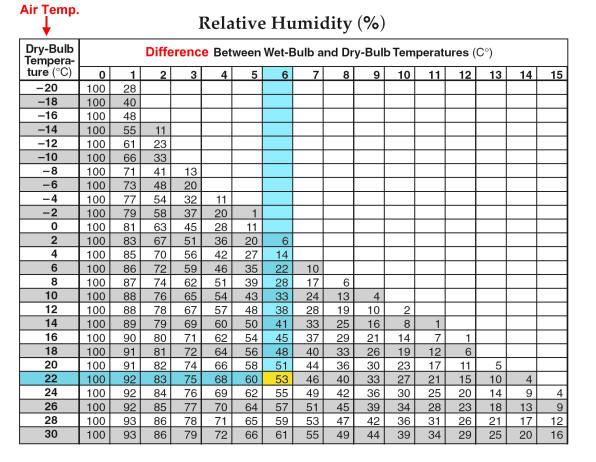wow, that RH seems high to me, at least from what I've read and my own experience. You dont run into any PM or bud rot issues? 65-80% is your nighttime RH too, or just your daytime? Thanks again
this is a copy n paste from another website, I couldn't find the VPD chart, but will continue to look. I had it on an old computer that is gone. I was introduced to VPD from some of ttystikk's posts, now I've been addicted to the subject lol
Before I continue with a description of some of our experiments, it seems appropriate to add a
brief discussion of the terminology associated with the study of humidity. To a certain degree, many of the
misconceptions and inaccuracies related to the interaction between humidity and plants have been fostered
by the way we measure and talk about humidity. The average individual uses the term “relative humidity”
with confidence and ease. Humans have a general “feel” for this assessment of atmospheric moisture that
makes it relevant to their relationship and interaction with the aerial environment. It seems natural,
therefore, to continue to apply this measure of humidity in research associated with greenhouse humidity
control or in attempting to outline a management strategy of humidity control in the greenhouse.
Relative humidity, as we are all reasonably well aware, is a measure, in percent, of the amount of
water vapor in the air compared to the total amount of water vapor that could be in the air at a given
temperature. Of course, as the air temperature rises, its capacity to hold water vapor also increases and,
conversely, as air temperature falls it will hold less and less water vapor. So, arriving at this common
measurement of aerial moisture requires knowledge of the relationship between water vapor concentration
(or partial pressure) and air temperature. This allows us to predict the absolute maximum quantity of
moisture that the air will hold at a given temperature which we then divide into the actual quantity of
moisture present at the time of our measurement and multiply by 100 to arrive at “percent relative
humidity”. Sadly, mental arithmetic is a lost art in this age of the computer so the trusty hand held
calculator (or its equivalent in the circuitry of most solid state sensors) helps us to the final answer.
Unfortunately, even the most sophisticated, genetically manipulated plant species has yet to master the
simple calculator or even simpler mental arithmetic to achieve this evaluation of humidity.
Plants cannot respond to or detect moisture that is present in the air (until it condenses or falls on
them) but instead respond to atmospheric demand for moisture, which is another way of defining the
moisture that is not present in the air. That is the vapor pressure deficit and is the difference between
the actual concentration or partial pressure of water vapor in the air and the maximum possible
concentration at that temperature. It doesn’t require that the plant have any knowledge of arithmetic or
predictive relationships. The plant simply opens its stomatal pores as the sun rises and permits the
evaporation of water from the leaves in response to the atmospheric demand established by prevailing
ambient conditions. If the atmosphere becomes too demanding, plants exercise a variety of mechanisms to
cope and still maintain physiological functions. Viewing humidity from the plant’s perspective was the
first step in approaching a rational strategy of humidity control.
Therefore, all of our measurements of humidity which were to be correlated with plant
physiological and growth responses were evaluated as vapor pressure deficit (VPD) rather than relative
humidity (RH). Our greenhouse environment control responded to VPD feedback and our set points were
established in units of millibars (mb) which is a pressure unit. Concentration units (eg. g/m³ are also
common. To put the units in perspective, a VPD of 10 mb at a temperature of 20 C represents a relative
humidity of about 56%, 10 mb at 30 C is closer to 76% RH. TO make the point about atmospheric demand
more clearly, 80% RH at 20 C represents a VPD of about 4 mb. Raising the temperature to 30 C but
maintaining the same 80 % RH results in a VPD of 8 mb. Thus, even though the relative humidity
remained unchanged, the atmospheric demand for moisture felt by plants was doubled.
-------------------------------------
Along with Dixon's paper, Ohio State has an article discussing VPD and it's use in greenhouses -
http://ohioline.osu.edu/aex-fact/pdf/0804.pdf
and a paper titled "The Control of Atmospheric Humidity in a Closed System" by B. D. Bolas of the Imperial College of Science and Technology of London also touches on VPDs use instead of RH -
As for whether this method of humidity measurement is better for cigars or now has one very large caveat - do you have temperature issues? Are you able to maintain right at or around 70F? If so, RH is perfectly fine. Are you like me who is forced to store you precise cargo in a hidden place within the homestead and you may have less than ideal temperatures during the year? If so, VPD may be the better way for you to judge what RH you should be holding your humidor at in order to give you that pleasant 70F/65% smoke after your stogies have been down at 60F during the winter or God
forbid 80F during the summer.
Another issue regarding the use of VPD as a humidity measurement is let's say in my case, VPD says I should be holding my sticks at 50% RH at 60F. What method of humidification is going to help me hold 50%RH? I've already begun designing a system that may do just that.
All that aside - what does everything think about Vapor Pressure Deficit vs Relative Humidity? Scientific "Kool-Aid"? Applies to living plants but not 'dead' plants such as ours?
In the words of Hillary - "Let's Talk....Let's Chat"






